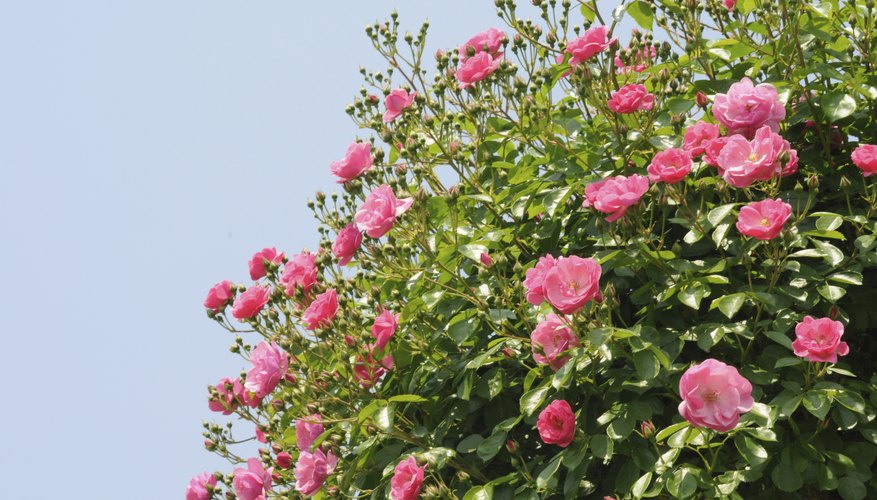Caterpillars are the larvae of moths and butterflies, and many species like to feed on roses. Usually it's not necessary to treat plants because the damage they cause isn't serious. However, a few caterpillar species cause extensive damage. You can mitigate damage by choosing rose varieties that aren't as susceptible to insect problems.
Leafroller
Newly hatched fruit tree leafrollers are green caterpillars with black heads and small, black plates located just behind their heads. As the caterpillar grows, the head turns dark brown and the plate turns beige to olive green. Fully mature caterpillars are 1.8 to 2.5 cm (3/4 to 1 inch) long. The caterpillars roll up leaves, which they web together, then feed on rose leaves from the safety of their leaf shelters. Leafrollers can completely defoliate a rose bush in a severe infestation, but healthy roses usually don't have a problem recovering. Predators include parasitical wasps, tachinid flies, lacewing larvae and assassin bugs, as well as some birds. Sprays are usually ineffective because the fruit tree leafroller only produces one generation a year, and by the time extensive defoliation has occurred, the caterpillar is almost ready to pupate.
- Newly hatched fruit tree leafrollers are green caterpillars with black heads and small, black plates located just behind their heads.
- Sprays are usually ineffective because the fruit tree leafroller only produces one generation a year, and by the time extensive defoliation has occurred, the caterpillar is almost ready to pupate.
Omniverous looper
Omnivorous looper caterpillars are pale yellow, while older caterpillars are usually yellow to pale green or pink, with gold-coloured heads. Mature caterpillars grow to be 5 to 6.2 cm (2 or 2 1/2 inches) long and have dark brown, black, green, or orange lines down their sides. When moving, the caterpillars stretch their bodies forward, then draw their rear up to meet their front legs, forming a loop, for which they are named. Outbreaks of this caterpillar are more common after malathion has been sprayed because the malathion kills looper predators, including parasitical wasps, spiders, assassin bugs, lacewings and pirate bugs. Looper populations are also kept in control by outbreaks of the granulosis virus, which they are susceptible to.
- Omnivorous looper caterpillars are pale yellow, while older caterpillars are usually yellow to pale green or pink, with gold-coloured heads.
- Outbreaks of this caterpillar are more common after malathion has been sprayed because the malathion kills looper predators, including parasitical wasps, spiders, assassin bugs, lacewings and pirate bugs.
Tussock
The whitemarked tussock moth caterpillar is a cream-coloured caterpillar with broad black and grey stripes, a reddish orange head and red dots. In addition, it has four tufts of light tan hairs on its back. Fully mature caterpillars grow to be 2.5 to 3.1 cm (1 to 1 1/4 inch) long. Young caterpillars eat leaf areas between the veins; older caterpillars eat everything except the larger veins. Caterpillars can be picked off by hand and put into a pail of soapy water to kill them. Pesticides aren't usually needed unless an infestation is severe.
- The whitemarked tussock moth caterpillar is a cream-coloured caterpillar with broad black and grey stripes, a reddish orange head and red dots.
- Young caterpillars eat leaf areas between the veins; older caterpillars eat everything except the larger veins.
Budworm
Tobacco budworms don't limit themselves to eating tobacco plants. They enjoy eating rose petals and also bore into the buds. These striped caterpillars vary in colour, depending on the colour of the flower they're eating, but they can be green, red or light brown. Budworms can be controlled on small plantings by handpicking them at dusk, when they're easier to see. A chemical insecticide may be necessary if you have a lot of rosebushes. Use a product with synthetic pyrethroid.
- Tobacco budworms don't limit themselves to eating tobacco plants.
Tent
The Western tent caterpillar is an orange and black caterpillar with blue and white markings and tufts of white and orange hair. Young caterpillars stay in large silk tents at night and feed in groups during the day, usually eating all the leaves on one stem before moving to another location. Mature caterpillars split up and feed on several stems at a time. Control caterpillars by removing the entire stem that contains the tent and the caterpillars and destroying it. You can also spray your roses with Bacillus thuringiensis, a biological insecticide.
- The Western tent caterpillar is an orange and black caterpillar with blue and white markings and tufts of white and orange hair.
- Mature caterpillars split up and feed on several stems at a time.
